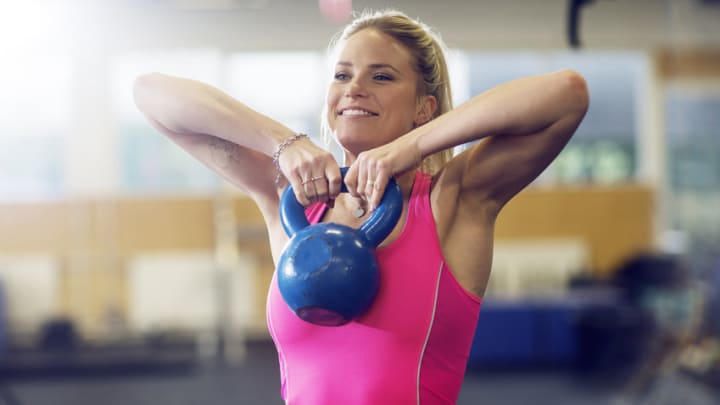7 reasons you're not building muscle even though you're lifting weights

You've been spending tons of time in the gym trying to get Michelle Obama arms, but you don't seem to be building any muscle. What gives?
Several things could explain why your arms are as noodly as ever (or why your butt isn't getting any bigger or your shoulders don't look any more sculpted)—and most of them are completely under your control. Here, our experts uncover reasons you’re not building muscle so you can make the changes you need to make all your hard work pay off.
You’re doing mostly cardio
Don’t get us wrong—cardio is important for keeping your body fat down and keeping your heart health in check. (Bonus points if you run or bike, since outdoor exercise is linked to better energy and improved mental health.) But when it comes to building muscle, hitting the treadmill won't help you much. “Every component of exercise, minus cardio, can help with muscle hypertrophy,” which is the scientific term for muscle building, says Michelle Lovitt, an exercise physiologist and trainer in Los Angeles. “Cardio tends to burn calories and puts your body in a deficit, which is great for leaning out, but not building mass.”
Adidas unveils its new Sub2 marathon shoe ahead of Tokyo Marathon
You’re not using heavy enough weights
Those 5-pound dumbbells were a great place to start as a beginner, but if you've been lifting weights for a while, it's time to bump up the weight. “You can use both exercise machines and free weights,” explains Michele Olson, PhD, exercise physiologist, professor of exercise science at Auburn University Montgomery, “but, if you are not lifting heavy enough weight, it doesn’t matter if you are primarily using free weights or machines.” In order to build muscle, you must break down muscle tissue using a weight that is challenging enough to cause micro-tears, which when repaired, form denser, stronger fibers.
You’re not sleeping enough
Those micro-tears that are such a key factor for muscle-building need rest to rebuild themselves and grow stronger. When do they do that? When you’re asleep! “You have to rest and feed your muscles between workouts or you will tear them down and they will become weaker,” says Olson. “Over time, you run the risk of over-training, which can result in injury, and possibly even more sleep troubles.”
Related Post: The Best Protein Powders for Muscle Gain
You’re inconsistent with your routine
If you're serious about putting on some muscle, then the most efficient way to do it is with three intense resistance training sessions and two lighter intensity workouts per week. “You need to have consistency in a workout program, hitting at least each muscle group two times a week to build muscle,” explains Lovitt. If you’re looking to switch up exercises, Olson suggests swaps such as sumo squats instead of traditional squats; step-ups on a bench instead of lunges; and then rotating back to the former. “These types of variation can be very effective in developing muscles, but the weights must still be fairly heavy that you’re using,” she says.
Caffeine, exercise and the brain: How 'doping' with psychoactive drugs can boost motivation
You’ve developed muscle imbalances
A muscle imbalance—when one muscle is stronger than its opposing muscle—can limit your ability to exercise effectively, and could lead to injury down the line. “It’s important to recognize whether you’re really working the muscles you think you are and recognize if you’ve developed an imbalance that alters your movement pattern,” says Eric Ingram, physical therapist at Louisiana Physical Therapy Centers of Pineville. One common imbalance in women is stronger quads and weaker, tighter hamstrings, thanks to prolonged sitting, high heels, and improper training. If you suspect you have a muscle imbalance, make an appointment with a physical therapist, who will prescribe exercises to even you out.
You have bad form
It’s not just about lifting—it’s about lifting safely and correctly. And if you’re not performing exercises properly, it’s impossible to make any progress. “When someone is just starting to work out, it can help to work closely with a knowledgeable personal trainer in order to learn proper form,” says Ingram. But that goes for experienced lifters, too. If you aren’t sure about a movement, it’s better to ask. “If you’re not working the correct muscles, you can’t expect them to grow,” explains Ingram.
Your genetics may not be working in your favor
It’s true—your genes can play a role when it comes to building muscle. In general, there are two types of muscle fibers: Type I, which are slow twitch, and Type II, which are fast twitch. Depending on which you have more of, you may have an easier or harder time gaining muscle. “Fast twitch muscle fibers are two times as thick as slow twitch muscle fibers, lending to the overall thickness of the muscle without any activity,” explains Lovitt. “Those people with a genetic predisposition of a high percentage of these fibers can increase muscle size very easily while the people with a higher percentage of slow twitch muscle fibers have to work really hard to put on mass.” It’s the reason why a world-class sprinter genetically has more fast twitch muscle fibers than a world-class marathoner—it comes down to what we’re born with.
This article was originally published on Health.com.
